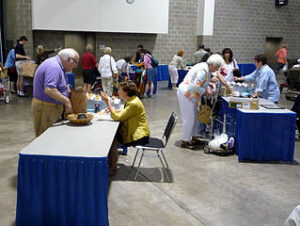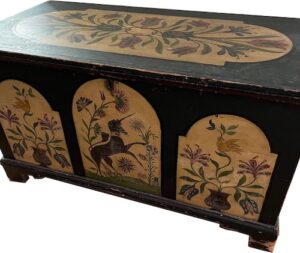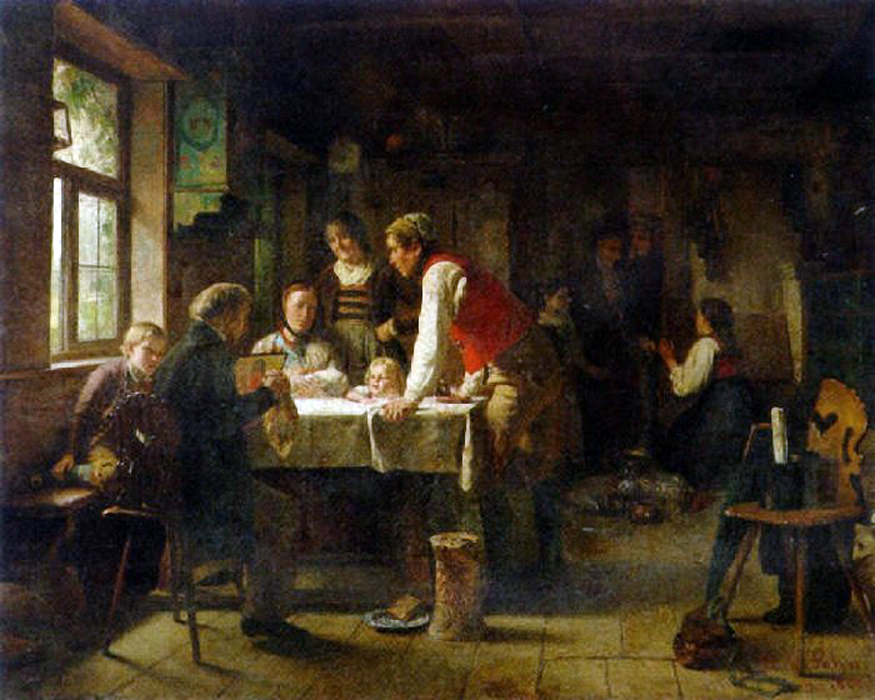By Peter K. Tompa[1]
Joan, Georgia, and Janice were longtime friends who enjoyed antiquing together. They read in the newspaper that their local PBS station was hosting an “Antiques Roadshow” event to benefit public broadcasting. The friends agreed that they would each bring a treasured family heirloom to the event to learn what “the experts” said it would be worth.

Austrian Art Nouveau vase, c. 1905. Source: Heritage Auctions.
Joan brought a beautiful Austrian Art Nouveau Pewter vase that her Great Aunt Gretyl had given her decades ago. According to family lore, Aunt Gretyl grew up in a wealthy household in Vienna, but she immigrated with her family to America in the aftermath of WWI and the severe dislocation it brought with the breakup of the Austro-Hungarian Empire. For Aunt Gretyl, the vase was one of the few tangible links she maintained to her old life. Joan recalls that the vase always contained roses, carnations, and even edelweiss, flowers popular in Austria to this day.
Georgia selected a hand painted Pennsylvania Dutch blanket/dowry chest which her mother had purchased at an antique store thirty years ago. Her mother was very proud of her purchase, and Georgia remembered the chest being displayed prominently in her family’s living room. Georgia recently inherited the chest from her mother’s estate. She was happy her mother had given it to her, rather than to her younger sister, who had no interest at all in antiques.
Janice brought a French Art Deco Aquamarine, Platinum, White Gold Clip-brooch that had been handed down from her grandmother, Arlene. The brooch came with an appraisal done 20 years ago by a reputable jeweler. According to her mother, the brooch had been a gift from one of her grandmother’s many suitors; apparently, Janice’s grandmother was quite a beauty in her day. Although Arlene eventually married another man, she always treasured the brooch because it reminded her of all the attention she had received from eligible bachelors in her youth.
These heirlooms had sentimental value to the friends based on their fond memories of their loved ones and what these objects meant to them, but all went to the event hoping that their treasures would also have a substantial monetary value in today’s dollars. The friends promised that the one whose heirloom was worth the most would buy lunch for the others to celebrate their “newfound wealth.”

Ticketed guests to Antiques Roadshow first visit the general appraiser’s tables. They quickly examine and categorize the items. Author Bobak Ha’Eri, Madison, WI, 2009, Wikimedia Commons, CC-By-SA-3.0 license.
The appraiser provided a good overview of the subject. It is often said that “value is in the eye of the beholder,” but setting specific values for art, antiques and other collectibles is often important for different purposes. The purpose may in turn impact the extent of that value.
Generally speaking, fair market value is the value an item will bring on the open market. The American Society of Appraisers considers fair market value as “An opinion expressed in terms of money, at which the property would change hands between a willing buyer and a willing seller, neither being under any compulsion to buy or to sell and both having reasonable knowledge of relevant facts, as of a specific date.”
Fair market value must be distinguished from auction value and value for insurance purposes. Auction values are for objects sold at an auction to willing buyers. An auction value may be lower than the fair market value, at least where the object is a common one. However, if the object is rare and desirable, the value could be astronomical. That is the reason many fine pieces that are in demand go to auction. In contrast, insurance value generally means the value it would take to replace a piece. Often, insurance policies require rare pieces to be valued in the policy itself which limits any disputes as to what an object is worth.
Insurance policies may further define replacement value. Replacement value may be based on the cost of a new example or a second-hand object in comparable condition. Alternatively, the cost can sometimes be based on recreating the original with comparable materials.

Art Deco aquamarine, platinum, white gold, clip-on brooch, French. Image Heritage Auctions.
An appraised value relates to fair market value, but it is provided by a trained professional. Appraisers should follow the Uniform Standards of Professional Appraisal Practice to ensure that their opinions comply with industry practices.
Appraisals become important for tax purposes, for example for charitable contributions of art and collectibles. An appraisal must be included with any taxable transfer of art or collectibles worth over $5,000.00. Appraisals also may become necessary for other reasons as well, for example if a piece of art is going to be used as collateral for a loan.
Appraisers may be associated with recognized organizations that offer training and certifications. Recognized appraisers in the fine art field are associated with the American Society of Appraisers, the Art Dealers Association of America, the Appraiser Association of America, the Appraisal Foundation, the International Society of Appraisers, and the Private Art Dealers Association. The key criteria for IRS appraisals, however, is that the appraiser actually be an expert in the field.
For antiques and collectibles of lower values, the informal opinion of a recognized dealer in that type of object may suffice. Alternatively, price guides can provide some guidance. “Kovels’ Antiques & Collectibles Price Guide” gives recent prices paid for more than 700 categories of antiques and collectibles. There is a “Guidebook to U.S. Coins,” popularly known as the Red Book. Other guides cover baseball cards and postage stamps.
There are also price guides on the Internet. The Numismatic Guarantee Corporation (NGC) offers free Internet price guides for U.S. and Foreign coins as an adjunct to its business of slabbing and grading coins. See https://www.ngccoin.com/price-guide/united-states/ and https://www.ngccoin.com/price-guide/world/ . There are a host of other Internet price guides for other collectibles as diverse as Hot Wheels and Barbie Dolls. See, for example https://www.hallsguide.com/price-guide-index/ and https://www.barbiedb.com/ .

Mother’s Pennsylvania Dutch painted chest. Author Peter K. Tompa, 2022.
And what about the friends’ treasures? Joan learned that her Great Aunt Gretyl’s Austrian Art Nouveau vase was worth over $1,000 based on auction records of a similar item. The “Antiques Road Show” expert told her that it was a particularly fine specimen meriting such a price. Janice was pleased by the news.
Georgia was disappointed to learn that her mother’s Pennsylvania Dutch blanket/dowry chest did not appreciate much beyond the $1,000 her mother paid decades ago. Such items simply are not as popular as they once were, especially with the younger generation. Moreover, this particular chest had been repainted, which detracted from its value.
In contrast, Janice was astounded to learn that her grandmother’s brooch was worth quadruple the $1,000 appraisal that was prepared 20 years ago. The appraiser told her that the quality of the brooch merited her $4,000 estimate, and possibly substantially more at auction.
After Janice learned about the good news, she happily told her friends, “Lunch is on me.”
Next month: Why does a French auction house want to know so much about me?
Further Reading
How much is your stuff worth? It’s often a good investment to spend the time and money on an appraisal, Consumer Reports Magazine (November 2018)(last visited August 25, 2022).
Tips for Art Collectors: Comparing Fair Market and Insurance Valuation for Fine Art, Sybaris.com (last visited August 25, 2022).
[1] Peter K. Tompa has written extensively about cultural heritage issues, particularly those of interest to the numismatic trade. Peter contributed to Who Owns the Past?” (K. Fitz Gibbon, ed, Rutgers 2005). He currently serves as executive director of the Global Heritage Alliance. This article is a public resource for general information and opinion about cultural property issues and is not intended to be a source for legal advice. Any factual patterns discussed may or may not be inspired by real people and events.
 Paul Eduard Richard Sohn, The appraiser's visit, 1866. Public domain.
Paul Eduard Richard Sohn, The appraiser's visit, 1866. Public domain. 

